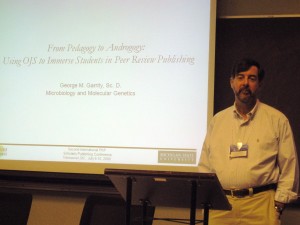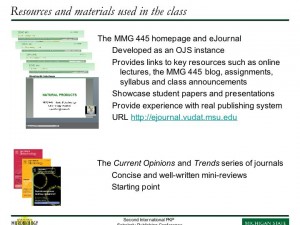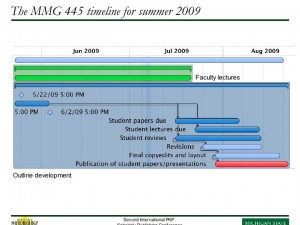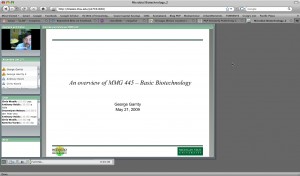Presenters: Steven Andrew Plato II and Andrew James Wyman (remotely), David Solomon in-house
July 10th, 2009 at 3:30 p.m.
Background info
Steve Plato and Andrew Wyman are third-year medical students from Michigan State University who saw a need in the literature for a dedicated place for medical students to publish their work and founded The Medical Student Research Journal (MSRJ) in 2007. They are due to publish the first issue this fall.
Session Overview
The session got off to a rough start with a few technical difficulties (due to new too-loud speakers in the meeting room at Simon Fraser University). The students gave the presentation from their editorial room in Michigan via Adobe Connect Pro. They use this to connect with the many geographically diverse authors/editors/faculty associated with their journal. The image, Powerpoint and voice are very clear. This is an exciting software tool for all distributed learning models.
The students went on to explain that they started the journal to fill a gap. Most students have extensively researched their chosen field of specialty throughout medical school, but often do not know how or where to publish their work. Whereas 60-100% (depending on specialty) of medical students matching to their first-choice residency stated they had extensive research in their field, the proportion of those that had published was as low as 35% for some specialties. MSRJ is peer-reviewed, authored and edited entirely by medical students which they hope will be the go to journal for medical students to publish that work.
This project was started at the Michigan State University but the creators hope to reach medical students throughout the US as well as internationally. THE MSRJ uses Open Journal Systems (OJS) and Creative Commons licencing to ensure communication and availability of publication to all medical students. This project is similar to a one started a few years earlier by the same institution (MSU) in a graduate biotechnology course (see session blog from this conference) however on a much quicker timeline, around 28 days!
OJS has been very helpful for the med students as it helps to facilitate their multi-location system, has low overhead and allows them rolling publication with minimal delays. They also like the management tools that help to guide novice editors (reminders/checklists) to make the process simple. OJS also tends to being in a larger readership.
Faculty
Faculty assure quality peer-review. Students are trained by faculty in critical appraisal, principles of scientific writing and academic integrity. They are also able to review a mock article and can compare their reviews to similar good and poor examples to learn to become a better reviewer. Faculty also provide guidance on sustainability and establish good practice in mentees (more hands-on and one-on-one time with people who know the literature the best). The students all go through an online training module, from the Annals of Emergency Medicine, prior to starting as well.
Usually one faculty will mentor 3-4 students per article. This helps less experienced reviewers in specific fields. They also provide feedback and guidance on where a review may be lacking. Students can then re-review and submit, then the editor decides to accept, accept with revisions or decline the article.
Sustainability plans?
Many other journals before this have struggled with longevity. MSRJ have instituted a student replacement policy (juniors that will take over when the current editors are done) and training sessions for editors which serve as quality control. In addition a letter from the Dean will be placed into the student file for encouragement to participate and to continue the job. Faculty are also rewarded by recognition in published material as well as a formal letter to their respective Departmental Chair. An annual report with statistics on publications is also planned for accountability
Finances?
The students plan for this journal to be a free or very low cost venture. All labour is by students or faculty. There is a minimal cost for the website host, however their major cost is copyediting, which they hope will be eliminated by using university resources. XML generation is also a marginal expense as is website development.
Benefits
The students feel the benefits are quite clear. They build experience in scientific writing and editing as well as get a head start on publications for their career. It is also strongly beneficial for those students doing research outside academic centres such as rural and distributed sites.
Since Open Journal System (OJS) has become a forerunner in educational resources, many other institutions have been able to start similar projects, with one just ready to launch this fall here at my home institution, UBC. The UBC Medical Journal will provide medical students with a forum to publish their research work that previously had no definitive place for publication.
Questions from the audience
1. I understand medical school is an intense experience. Do you have to sacrifice other parts of the educational experience to participate?
While it is true it is intense, but one thing about medical school is it does allow you to do things outside of school. Most students are involved in extracurricular activities already and 60-100% already involved in research. There will be some sacrifice, but usually that would be less time for research projects (i.e. one instead of two). The time intensity of the reviewer part of the job is not significant. Students only review one article at a time. There is a base here already, but it does take away time, hopefully that time is well spent.
2. Are the training materials you used publically available?
Yes they are online in the Annals of Emergency Medicine Journal. They have a great online flash based training process that we used.
3. Do you plan on only accepting articles from MSU or do you plan to open the journal up to other universities?
This journal will be open to med student/residents around the world once it is started. MSU is unique in their distributed plan in the states. Right now, you can submit from anywhere, but we hope to expand reviewers across the country.
Related links
The Medical Student Research Journal
Andrew@msrj.chm.msu.edu
Steven@msrj.chm.msu.edu
dsolomon@msu.edu




